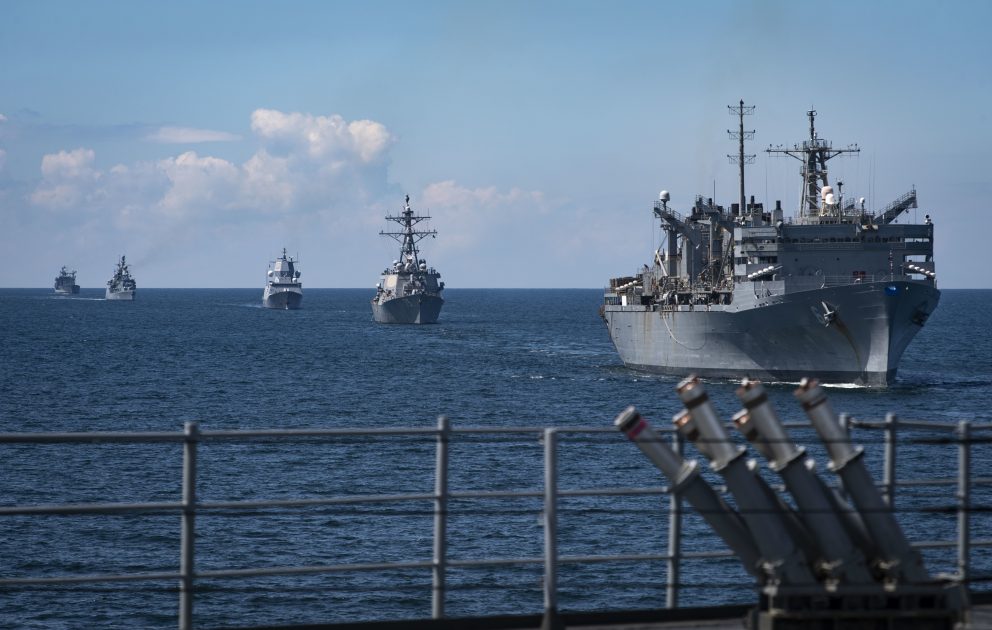The 50th iteration of the U.S./NATO-led Baltic Operations (BALTOPS) began on June 6 and will continue until June 18. With the Naval Striking and Support Forces NATO and Sixth Fleet (the two share a commander) at the head, this year’s exercise includes 40 military vessels, 60 aircraft and 4,000 troops from 16 NATO nations and two partners: the U.S., Belgium, Britain, Canada, Denmark, Estonia, France, Germany, Italy, Latvia, Lithuania, the Netherlands, Norway, Poland, Spain and Turkey, and Finland and Sweden, respectively.
The maneuvers, which will include anti-submarine warfare drills, practicing of integrated air defenses and amphibious landings, occur in a sea where there are nine littoral states: Denmark, Estonia, Finland, Germany, Lithuania, Latvia, Poland, Russia and Sweden. U.S. Air Forces in Europe and Air Forces Africa recently said of Arctic claimant nations – against the backdrop of the current U.S.-NATO Arctic Challenger 21 war games in the High North (northern Scandinavia) – that “Seven out of eight Arctic nations are NATO members or Enhanced Opportunity Partners….”
Similarly with the Baltic Sea region: eight of the nine states bordering the sea are NATO members or Enhanced Opportunity Partners, all of which are participating in the exercise. Russia alone among Baltic countries is not a participant in this year’s BALTOPS. It is the target.

This year’s rendition of the war games – try to imagine if you will the during the Cold War the Soviet Union recruiting every nation in the Western Hemisphere except the U.S. into the Warsaw Pact and conducting war games with them in the Gulf of Mexico and throughout the Caribbean – happen against the backdrop of unprecedentedly strained relations between the world’s two main nuclear powers; according to everyone from the late scholar Stephen Cohen to former Russian president Dmitry Medvedev worse than during the Cuban Missile Crisis that brought the world to the brink of a nuclear catastrophe.
In addition to the Black Sea region, the Baltic Sea is a potential flashpoint in any future NATO-Russian conflict. One in which, as seen above, Russia is outnumbered eight-to-one, with the U.S. siding with its local NATO adversaries. Russia’s exclave of Kaliningrad is on the Baltic Sea and Russia’s Union State partner Belarus is not far from it. Belarus has recently been identified as an enemy by NATO and, in an accusation as ludicrous as it is provocative, a military threat to Ukraine by the latter’s president.
The Naval Striking and Support Forces NATO and U.S. Sixth Fleet commander,U.S. Vice Admiral Gene Black, said of the exercise:
“This year, we celebrate the 50th BALTOPS, an exercise that sets the foundation of interoperability across the Alliance. BALTOPS stands as the keystone of our exercise season, demonstrating half a century of the unwavering commitment of our partners and Allies. Lessons learned in BALTOPS enable international strike group operations, advanced missile defense capabilities and seamless surface action group missions.”
If anyone in Moscow is still missing the point, a NATO press release should bring clarity to the matter when it states:
“The exercise enhances flexibility and interoperability among allied and partner nations to strengthen combined response capabilities, as well as demonstrate international resolve to ensure stability in, and if necessary defend, the Baltic Sea region.”
NATO’s Eastern Flank, described as extending from the Arctic to the Caucasus, is NATO’s current war front as well.
Rick Rozoff is a contributing editor at Antiwar.com. He has been involved in anti-war and anti-interventionist work in various capacities for forty years. He lives in Chicago, Illinois. He is the manager of Stop NATO. This originally appeared at Anti-Bellum.


